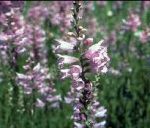 This herbaceous perennial is also called western false dragon head is a member of the deadnettle family, Lamiaceae, that also includes basil, monarda and ajuga. It is native to Manitoba to British Columbia, south to Illinois, Utah, and Oregon where it grows in marshes, streams and lake margins in lowlands and montane zones. Plants have a rhizomatous root system and simple or branched 4-angled stems 8-40″ tall. The sessile leaves are linear and up to 4′ long with pointed tips and finely toothed margins. In summer, terminal and axillary spikes 3/4″-3″ long of white, pink or lavender flowers appear. Each funnel-shaped flower is up to 3/4″ long, is subtended by an egg-shaped bract ,and has two lips, the upper hooded, and the lower 3-lobed. The fruit consists of 4 egg-shaped nutlets. The genus name, Physotegia, comes from the Greek words physa meaning a bladder, and stege, meaning roof cover and refers to the inflated calyx that covers the fruits. The specific epithet, parviflora, comes from the Latin words parvus meaning small and flos meaning flower.
This herbaceous perennial is also called western false dragon head is a member of the deadnettle family, Lamiaceae, that also includes basil, monarda and ajuga. It is native to Manitoba to British Columbia, south to Illinois, Utah, and Oregon where it grows in marshes, streams and lake margins in lowlands and montane zones. Plants have a rhizomatous root system and simple or branched 4-angled stems 8-40″ tall. The sessile leaves are linear and up to 4′ long with pointed tips and finely toothed margins. In summer, terminal and axillary spikes 3/4″-3″ long of white, pink or lavender flowers appear. Each funnel-shaped flower is up to 3/4″ long, is subtended by an egg-shaped bract ,and has two lips, the upper hooded, and the lower 3-lobed. The fruit consists of 4 egg-shaped nutlets. The genus name, Physotegia, comes from the Greek words physa meaning a bladder, and stege, meaning roof cover and refers to the inflated calyx that covers the fruits. The specific epithet, parviflora, comes from the Latin words parvus meaning small and flos meaning flower.
Type: Herbaceous perennial
Bloom: Spikes of small ,funnel-shaped, 2-lipped white, pink, or lavender flowers in summer
Size: 8-40″ H
Light: Full sun to part shade
Soil: Average, moist to wet
Hardiness: Unavailable
Care: Unavailable
Pests and Diseases:Unavailable
Propagation:Unavailable
Companion Plants: Unavailable